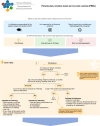Developing a personalised, evidence-based and inclusive learning (PEBIL) model of blended learning: A cross-sectional survey
- PMID: 37361734
- PMCID: PMC10071269
- DOI: 10.1007/s10639-023-11770-0
Developing a personalised, evidence-based and inclusive learning (PEBIL) model of blended learning: A cross-sectional survey
Abstract
Whilst the use of various blended learning models preceded the COVID-19 pandemic, the abrupt shift to remote delivery served as catalyst within the sector in enhancing digital solutions to meet immediate student needs. As we emerge from the pandemic, a return to purely didactic and impersonal in-person teaching seems anticlimactic, with the return to the lecture theatre seeing many lecturers trialling various digital tools in creating more interactive in-person, synchronous, and asynchronous sessions. In evaluating students' experiences of the various tools and approaches applied by academic staff, a survey was developed by a multidisciplinary team of educators at Cardiff University's School of Medicine exploring student perceptions of e-learning resources (ELRs), as well as student experiences of various blended learning approaches. The primary aim of this study was to evaluate student experience, satisfaction, and engagement with ELRs and blended learning. A total of 179 students (undergraduate and postgraduate) completed the survey. 97% confirmed that e-learning resources were blended within the teaching they received, with 77% rating the quality of e-learning as good-to-excellent and 66% reporting a preference for asynchronous resources that enable them to learn at their own pace. A variety of platforms, tools, and approaches were identified by students as meeting their diverse learning needs. We therefore propose a personalised, evidence-based and inclusive learning (PEBIL) model enabling the application of digital technologies both on and offline.
Keywords: Blended learning; Digital education; Medical education; Online educational technologies.
© The Author(s), under exclusive licence to Springer Science+Business Media, LLC, part of Springer Nature 2023, Springer Nature or its licensor (e.g. a society or other partner) holds exclusive rights to this article under a publishing agreement with the author(s) or other rightsholder(s); author self-archiving of the accepted manuscript version of this article is solely governed by the terms of such publishing agreement and applicable law.
Conflict of interest statement
Disclosure statementThe authors report no conflicts of interest (financial or otherwise). The authors alone are responsible for the content and writing of this article.
Figures






References
-
- Alammary A, Sheard J, Carbone A. Blended learning in higher education: Three different design approaches. Australasian Journal of Educational Technology. 2014;30(4):440–454. doi: 10.14742/ajet.693. - DOI
-
- Biber DD, Heidorn J. Tailoring the walking classroom to promote college student engagement. College Teaching. 2021;69(3):169–172. doi: 10.1080/87567555.2020.1833177. - DOI
-
- Biggs J, Tang C. Teaching for quality learning at university. McGraw-hill education (UK); 2011. pp. 281–322.
-
- Bruggeman B, Tondeur J, Struyven K, Pynoo B, Garone A, Vanslambrouck S. Experts speaking: Crucial teacher attributes for implementing blended learning in higher education. The Internet and Higher Education. 2021;48:100772. doi: 10.1016/j.iheduc.2020.100772. - DOI
-
- Castro R. Blended learning in higher education: Trends and capabilities. Education and Information Technologies. 2019;24(4):2523–2546. doi: 10.1007/s10639-019-09886-3. - DOI
LinkOut - more resources
Full Text Sources
Research Materials
